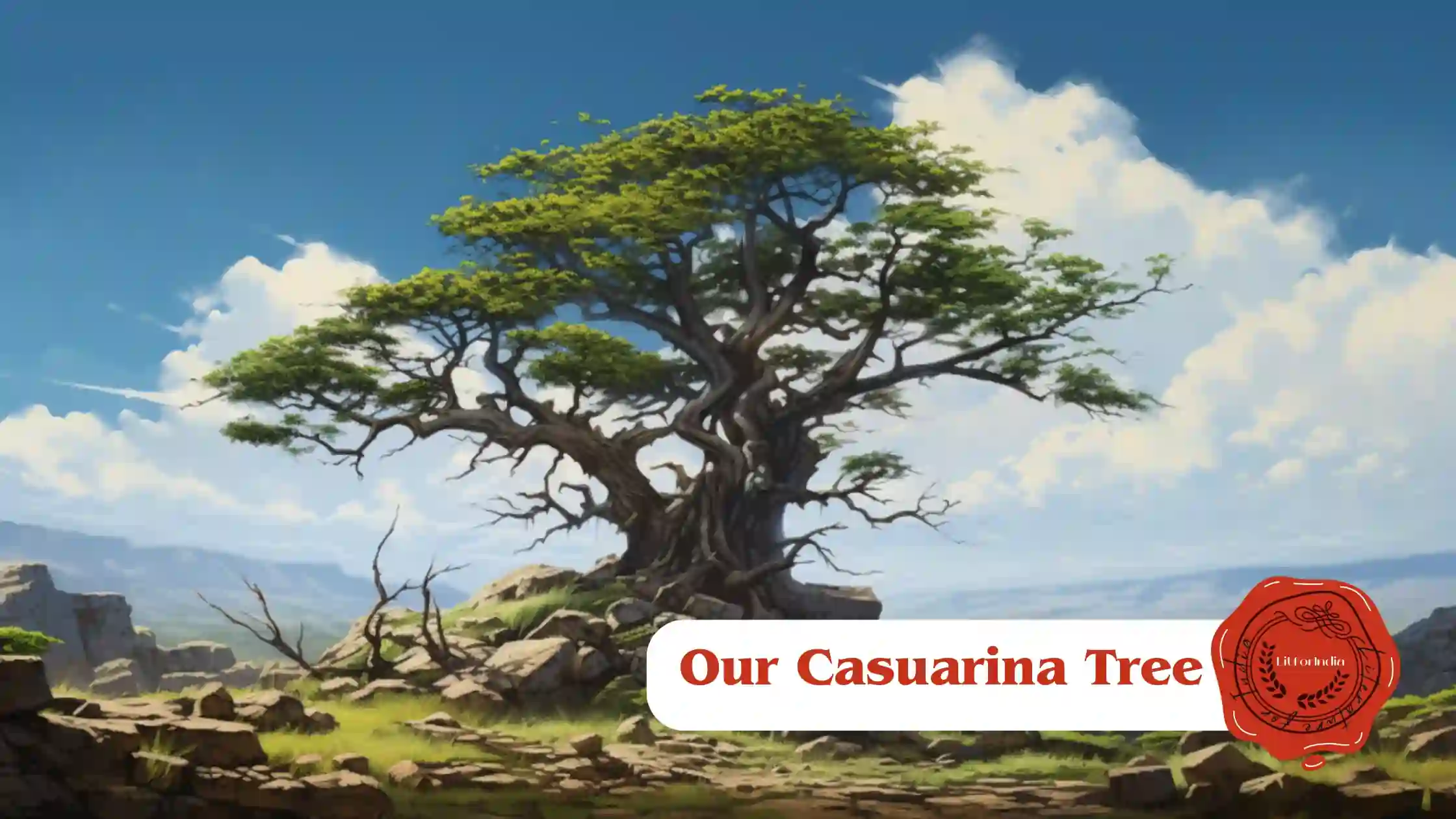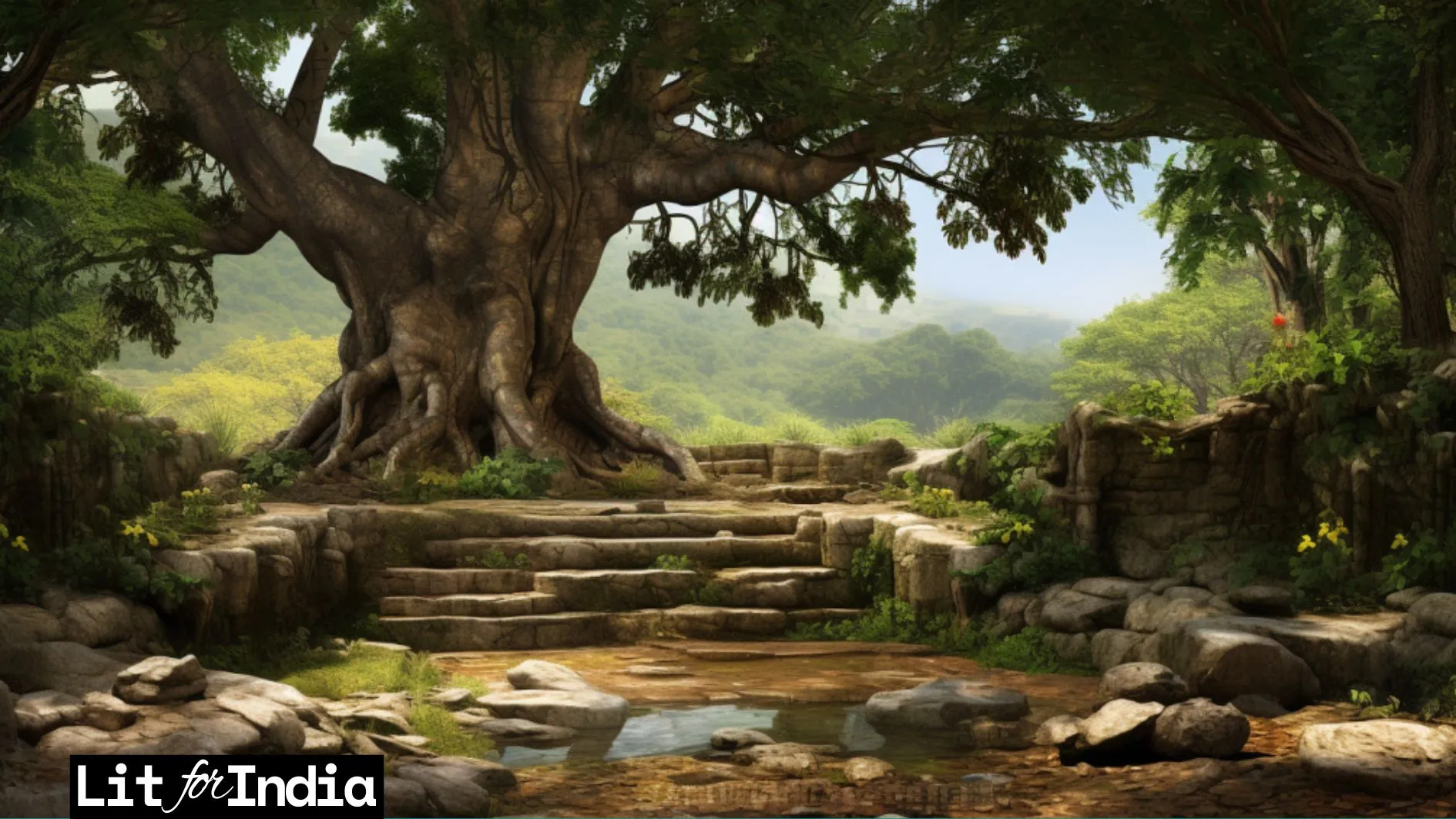“Our Casuarina Tree” is a profound poem written by Toru Dutt, an influential Indian poetess of the 19th century. This lyrical masterpiece captures the poet’s nostalgic longing for her ancestral home and the memories associated with a majestic casuarina tree. In this blog, we will explore the renowned poem “Our Casuarina Tree,” delving into its meaning, providing a summary of its content, and conducting an insightful analysis. Join us as we unravel the beauty and depth of this literary masterpiece.

Table of Contents
Our Casuarina Tree Summary
“Our Casuarina Tree” is a poignant and introspective poem written by Toru Dutt, a renowned Indian poet. The poem revolves around the majestic presence of a beloved casuarina tree and the memories it evokes in the poet’s mind. The tree becomes a symbol of nostalgia, representing the poet’s longing for her ancestral home and the cherished moments of her past. As the poem progresses, the poet delves into the intricate details of the tree, describing its scarred trunk, the baboon perched atop, and the vibrant crimson flowers adorning its branches.
The tree serves as a conduit for the poet’s emotions, invoking a sense of love, loss, childhood memories and longing. The poem beautifully captures the beauty of nature and the profound impact it has on human emotions. Through its evocative imagery and heartfelt sentiments, “Our Casuarina Tree” invites readers to reflect on the power of memory, the transient nature of life, and the enduring connection between humans and the natural world.
Themes in “Our Casuarina Tree”
Stanza One of Our Casuarina Tree
When first my casement is wide open thrown
At dawn, my eyes delighted on it rest;
Sometimes, and most in winter,—on its crest
A gray baboon sits statue-like alone
Watching the sunrise; while on lower boughs
His puny offspring leap about and play;
And far and near kokilas hail the day;
And to their pastures wend our sleepy cows;
And in the shadow, on the broad tank cast
By that hoar tree, so beautiful and vast,
The water-lilies spring, like snow enmassed.
In the first stanza, the poet begins by describing the tree itself. She remembers how the giant casuarina tree was entwined by a creeper, resembling a python, which had left a visible scar on its trunk. The poet emphasizes that no other tree could withstand such a tight hold, but this particular tree did, displaying its strength. The tree proudly wears these scars like a scarf, symbolizing its resilience. Additionally, the poet mentions that the tree is adorned with crimson flowers on every branch, resembling a crown that attracts birds and bees. During sleepless nights, the poet would listen to the endless music and sweet song that filled her garden, emanating from the tree.
Stanza Two of Our Casuarina Tree
When first my casement is wide open thrown
At dawn, my eyes delighted on it rest;
Sometimes, and most in winter,—on its crest
A gray baboon sits statue-like alone
Watching the sunrise; while on lower boughs
His puny offspring leap about and play;
And far and near kokilas hail the day;
And to their pastures wend our sleepy cows;
And in the shadow, on the broad tank cast
By that hoar tree, so beautiful and vast,
The water-lilies spring, like snow enmassed.
In the second stanza of ‘Our Casuarina Tree,’ the poet describes the delightful experiences she has during dawn. Every morning, as she opens her window, her eyes find joy in resting upon the tree. She highlights how the scene changes with the seasons. During other seasons, but mostly in winter, she has observed a grey baboon sitting still like a statue on the top branch, eagerly awaiting the first rays of sunlight. Meanwhile, the baboon’s small and playful offspring can be seen on the lower branches of the tree. In addition to this picturesque view, the poet also mentions the sweet calls of the kokilas, welcoming the new day. She has also witnessed the cows being guided towards the pastures and the water-lilies blooming under the shade of the ancient tree, resembling a gathering of snow.
Stanza Three of Our Casuarina Tree
But not because of its magnificence
Dear is the Casuarina to my soul:
Beneath it we have played; though years may roll,
O sweet companions, loved with love intense,
For your sakes, shall the tree be ever dear.
Blent with your images, it shall arise
In memory, till the hot tears blind mine eyes!
What is that dirge-like murmur that I hear
Like the sea breaking on a shingle-beach?
It is the tree’s lament, an eerie speech,
That haply to the unknown land may reach.
In the third stanza, the speaker becomes more personal as she reflects on the memories associated with the tree. She explains why the tree holds a special place in her heart. Beyond the joyful mornings, the tree reminds her of the times she spent playing with her siblings. The tree becomes intertwined with the memories of their deep love and companionship, evoking strong emotions that bring tears to the poet’s eyes. As she walks down memory lane, the poet mourns for those who are no longer with her. She imagines that the tree shares her sense of loss, which she perceives as a melancholic murmur, resembling the sound of waves breaking on a pebble beach.
Stanza Four of Our Casuarina Tree
Unknown, yet well-known to the eye of faith!
Ah, I have heard that wail far, far away
In distant lands, by many a sheltered bay,
When slumbered in his cave the water-wraith
And the waves gently kissed the classic shore
Of France or Italy, beneath the moon,
When earth lay trancèd in a dreamless swoon:
And every time the music rose,—before
Mine inner vision rose a form sublime,
Thy form, O Tree, as in my happy prime
I saw thee, in my own loved native clime.
In the fourth stanza, the poet establishes a deeper bond with the tree. Using the imagery of waves, she transports us to a distant and familiar land that is both unknown and well-known. She describes how the waves gently caress the timeless shores, creating a melodic symphony. Whenever this rhythmic music of the waves reaches her ears, it invokes memories of the tree that she had seen in her youth. The tree becomes intertwined with the evocative sounds of the waves, creating a powerful connection that resonates with the poet’s soul.
Stanza Five of Our Casuarina Tree
Therefore I fain would consecrate a lay
Unto thy honor, Tree, beloved of those
Who now in blessed sleep for aye repose,—
Dearer than life to me, alas, were they!
Mayst thou be numbered when my days are done
With deathless trees—like those in Borrowdale,
Under whose awful branches lingered pale
“Fear, trembling Hope, and Death, the skeleton,
And Time the shadow;” and though weak the verse
That would thy beauty fain, oh, fain rehearse,
May Love defend thee from Oblivion’s curse.
In the final stanza, the speaker expresses her desire to honour the casuarina tree. She acknowledges that those dear to her, who now rest in peace, also loved the tree. She wishes for the tree to live a long life, akin to the enduring yew trees of “Borrowdale,” a reference to Wordsworth’s work. Additionally, she reflects on the differences between the Casuarina tree and the trees of England, symbolizing her varied emotions. The Casuarina tree represents nostalgia, longing, and cherished memories, while the English trees represent her feelings of isolation. The closing lines of the poem emphasize the notion of a poem as a written memory. The poet calls upon “Love” to safeguard the tree and her poem from the ravages of time, underscoring their enduring significance.
Poetic Device Used in Our Casuarina Tree
The poem “Our Casuarina Tree” employs various poetic devices to enhance its imagery, evoke emotions, and convey the depth of the poet’s sentiments. Some of the prominent poetic devices used in the poem include:

- Imagery: The poet skillfully employs vivid and sensory imagery throughout the poem to create a rich visual and emotional experience for the reader. The images of the casuarina tree, the creeper winding around it like a python, the scar on the trunk, the crimson clusters, the baboon sitting statue-like, the kokilas’ calls, and the water-lilies springing forth all contribute to the immersive and evocative nature of the poem.
- Metaphor: The poet makes effective use of metaphors to convey her emotions and ideas. For example, the scar on the tree’s trunk is compared to a scarf, symbolizing the tree’s strength and resilience. The baboon on the tree’s highest branch is likened to a statue, emphasizing its stillness and anticipation. The water-lilies emerging in the shadow of the tree are compared to gathered snow, evoking their beauty and delicacy.
- Symbolism: The casuarina tree itself serves as a powerful symbol throughout the poem. It represents a connection to the poet’s past, her memories, and her sense of longing. The tree becomes a metaphorical bridge between the present and the past, carrying the weight of cherished experiences and emotions.
- Personification: The poet personifies nature in several instances, attributing human characteristics to elements like the waves gently kissing the shore, the kokilas hailing the day, and the tree itself. This personification adds depth and a sense of life to the natural world portrayed in the poem.
- Allusion: The poem makes an allusion to Wordsworth’s “Yew-trees” in the final stanza, where the poet references the enduring trees of Borrowdale. This allusion adds an intertextual layer to the poem, inviting readers to draw connections between different works of literature and deepen their understanding.
Structure and Form
The poem “Our Casuarina Tree” follows a structured and consistent form, contributing to its aesthetic appeal and rhythmic flow. It consists of six stanzas, each containing eight lines, and adheres to a regular rhyme scheme of ‘ABBACDDCEEE FGGFHIIHJJJ KLLKMNNMOOO PQQPRSSRTTT UVVUWXXWYYY’. This scheme creates a sense of harmony and musicality throughout the poem.
In terms of meter, the poem predominantly employs iambic pentameter, which consists of five pairs of unstressed and stressed syllables per line. This rhythmic pattern lends a natural and balanced cadence to the poem, enhancing its poetic flow.
The consistent structure and form of the poem provide a sense of order and coherence, allowing the reader to engage with the imagery and emotions in a systematic manner. The eight-line stanzas provide enough space for the poet to develop and expand upon each theme or idea before moving on to the next.
Conclusion
Our Casuarina Tree poem by Toru Dutt leaves a lasting impression through its profound exploration of longing, memory, and the enduring connection between humans and nature. The poem’s vivid imagery and evocative language invite readers to delve into the depths of their own emotions and reflect on the transient nature of life. It serves as a poignant reminder of the power of cherished memories and the significance of our roots.
Personally, the poem resonates with the universal experience of longing for a sense of belonging and the comfort of cherished moments from the past. Dutt’s skilful use of poetic devices, such as metaphor, symbolism, and imagery, enhances the lyrical beauty of the poem and deepens its impact. “Our Casuarina Tree” has left a lasting legacy and continues to inspire readers with its timeless themes and its ability to evoke profound emotions.
About Toru Dutt
Toru Dutt was an Indian poet born on March 4, 1856, in Calcutta. She contributed to English-language poetry and fiction, blending Western forms with Indian themes. Her works explored love, longing, nature, and Indian heritage. Dutt’s notable writings include “A Sheaf Gleaned in French Fields”, “The Tree of Life” and “Ancient Ballads and Legends of Hindustan.” Her lyrical beauty and vivid imagery continue to inspire generations of writers, making her an important figure in Indian literature.
FAQs
What is the theme of Our Casuarina Tree?
The theme of “Our Casuarina Tree” is the enduring power of memory and the profound emotional attachment to a beloved tree.
What kind of poem is Our Casuarina Tree?
“Our Casuarina Tree” is a lyrical and reflective poem.
Is our casuarina tree an elegy?
Yes, “Our Casuarina Tree” can be considered an elegy as it mourns the loss of a beloved friend and poet, Toru Dutt’s brother Aru, who has passed away.
What is a theme that is present in the poem the tree?
A theme present in the poem is the idea that nature, particularly the casuarina tree, serves as a source of solace, inspiration, and a connection to the past.
